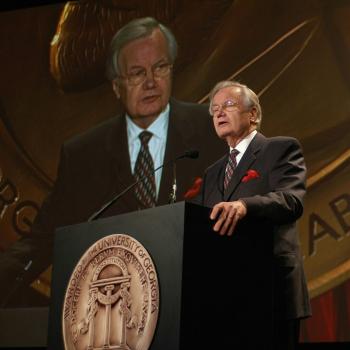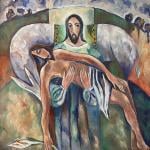
Troll the Yuletide carol, fa-la-la-la-la, la-la-la-la…. Hum a few fa-la-la’s and you may recognize the song as Deck the Halls. What about these words: make the Yuletide gay? It’s from the song Have Yourself a Merry Little Christmas. What is Yuletide? And what do Yuletide and Yule have to do with Christmas other than being mentioned in a few songs?
It turns out they have a great deal to do with Christmas.
How Yuletide Began
Ancient Germanic pagans introduced the 12-day winter festival called Yule or Yuletide several thousand years ago. Today’s festivities begin on the winter solstice, which is the shortest day of the year. Celebrations include singing and dancing, lighting candles, decorating homes and exchanging gifts.
The festival has become synonymous with Christmas for many people, and some modern-day neo-pagans celebrate Yule as well. Read more about it in several Patheos articles here.
In ancient times, Yuletide traditions included burning a large yule log for up to 12 days or until it burned out, decorating large trees with holly and ivy garlands and sacrificing animals to pagan gods. By slaughtering their cattle, ancient pagans avoided the problem of trying to feed a herd during northern Europe’s harsh winter months. It also fulfilled people’s need to make sacrifices and provided partygoers with enough meat for a feast.
At least that’s what some experts say.
Questions about Yuletide
The history of Yule/Yuletide isn’t clearcut because, as author and retired professor of religion Britt-Mari Nasstrom explains, “the scarcity of the resources restricts our knowledge of the pre-Christian yule/jol.”
What she means is that most ancient people were unable to read and write. In the absence of written records, today’s scholars make educated guesses about Yule and Yuletide.
Their educated guesses have led them to conclude that we get the word Yuletide from the Old Norse jol, which refers to a midwinter feast, and tide, which means time. Over time, Jol-tide became Yuletide.
But there is more to the story. “In Norse culture, Yule was believed to be the time when the spirits of the dead were passed on to the Otherworld to move on from the living world and to continue their afterlife there,” according to the Norse-focused website NorseGarde.
“These spirits were honored and celebrated during Yule, and animals were sacrificed in their honor. It was believed to be dangerous to go outside alone in the night during Yule, least one risked (being) carried away to the Otherworld before their time.”
The Celts – who lived in various parts of Europe — also celebrated Yule. Their focus was the sun’s rebirth and the coming new year, with a burning Yule log symbolizing the sun’s return. They also exchanged gifts in honor of their gods.
Reasons for Ancient Pagans to Celebrate
Some experts believe that Yuletide was one of the most important festivals in the ancient world. We know it coincided — by design — with the northern hemisphere’s winter solstice, which traditionally is observed on Dec. 21-22.
Why would people celebrate prolonged darkness and frigid temperatures? In truth, the pagans were celebrating the coming spring and summer rather than a severe winter. They saw winter solstice as the beginning of their ascent into the light of spring, and they celebrated the warmth and their continued survival.
What Does Yule Have to Do with Christmas?
So, we come back to the question: What does Yule have to do with Christmas?
Most of the ancient world was pagan before a new religion called Christianity began to take root in the first-century Roman province of Judea. The Christian faith had a few thousand followers by the end of the first century. And by the fourth century, it had grown to an estimated 25-35 million followers and had become the official religion of Rome.
Several factors led to Christianity’s rapid growth. The Christian message of salvation and eternal life was popular with many people, as was the religion’s acceptance of all classes. And Christians’ inclusive attitude toward women certainly didn’t hurt.
Missionaries such as the fiery Apostle Peter, the more introspective Luke and the prolific letter writer named Paul won over numerous converts. They established churches throughout the Roman empire, and Christianity continued to grow.
In the 10th century, King Haakon Haraldsson of Norway brought Christmas and Yule traditions together in his country. According to the story, he visited England and converted to Christianity and then declared that Norway’s Yule celebration on Dec. 25 would coincide with Christmas from then on.
Yule Traditions That Christians Kept
Christians adopted various Yule traditions such as burning a Yule log, building a Yule goat, hanging mistletoe, decorating with evergreens, lighting candles, exchanging gifts and singing carols, per Britannica.
The Yule log was a large log that ancient pagans burned to symbolize the return of the sun after winter. Some of the largest logs provided warmth and light for up to 12 days. Some people include Yule logs in their modern Christmas celebrations, though most of today’s logs are cakes decorated to resemble logs.
What about Yule goats? Swedes continue the tradition of building large Yule goats made of straw. These goats may originally have been created as a tribute to the god Thor, who supposedly rode in a chariot pulled by goats. Eventually, Yule goats became associated with Christmas and are seen as counterparts or companions of Santa in some countries.
The Significance of Evergreens
The Norse and Celts decorated their homes with evergreens such as mistletoe and holly during Yuletide. They believed the greenery brought them good luck while also warding off evil spirits, and the mistletoe symbolized friendship and love.
“Tree worship was common among the pagan Europeans and survived their conversion to Christianity in the Scandinavian customs of decorating the house and barn with evergreens at the New Year to scare away the Devil and of setting up a tree for the birds during Christmastime,” Britannica explained. Germans placed a Yule tree at the entrance or inside their homes during Yuletide.
Christmas Trees and Santa
Modern Christmas trees originated in western Germany rather than Scandinavia. Queen Victoria’s German husband, Prince Albert, introduced them to the English in the mid-19th century.
Victorian-era trees were decorated with small toys and gifts, candy, popcorn strings, candles and other small items. Earlier trees were decorated with apples, Britannica said.
Norse mythology may have contributed to the legend of Santa, as did traditions about Saint Nicholas of Myra and the Dutch people’s Sinterklaas. According to Norse tradition, the pagan god Odin had a long white beard and rode through the sky on an eight-legged horse during Yule. People left out food, oats and hay rather than cookies and milk.
What Does Yule Have to do with Christmas?
So, what does Yule have to do with Christmas? NorseGarde sums up Yuletide and Christmastime by saying, “While there are minor differences between Yule and Christmas, they both reflect the same essential theme: a time of renewal and unity. This is why Yule remains relevant today, even during the holiday season, forming the cornerstone of our winter celebrations.













